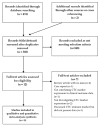Circulating Tumour Cell Expression of Immune Markers as Prognostic and Therapeutic Biomarkers in Head and Neck Squamous Cell Carcinoma: A Systematic Review and Meta-Analysis
- PMID: 33153130
- PMCID: PMC7662307
- DOI: 10.3390/ijms21218229
Circulating Tumour Cell Expression of Immune Markers as Prognostic and Therapeutic Biomarkers in Head and Neck Squamous Cell Carcinoma: A Systematic Review and Meta-Analysis
Abstract
Rates of loco-regional recurrence and distant metastasis remain high among head and neck squamous cell carcinoma (HNSCC) patients, despite advancing cancer treatment modalities and therapeutic agents. One area that has generated considerable interest is the immune landscape of the tumour, heralding a wave of immune checkpoint inhibitors with notable efficacy in recurrent/metastatic HNSCC patients. However, HNSCC remains poorly served by biomarkers that can direct treatment in a personalised fashion to target the tumour heterogeneity seen between patients. Detection and analysis of circulating tumour cells (CTCs) in HNSCC has provided a previously unseen view of the metastasis forming cells that are potentially contributing to poor clinical outcomes. In particular, identifying CTC expression of phenotypic and druggable protein markers has allowed CTC sub-populations to be defined that hold prognostic value or are potential therapeutic targets themselves. The aim of this systematic review was to examine the role of CTC immune-marker expression as prognostic/therapeutic biomarkers in HNSCC by evaluating progress to date and discussing areas for future research. Our results highlight how few studies have been able to demonstrate prognostic significance of immune-marker expression in CTCs. As expected, the immune checkpoint PD-L1 was the most widely investigated marker. However, no studies evaluated CTC target immune marker expression in immunotherapy cohorts. Despite these findings, the data presented demonstrate promise that CTCs may be a source of future biomarkers for immunotherapy and will provide valuable information regarding the potential immune evasion of these metastasis forming cells.
Keywords: HNSCC; circulating tumour cell; head and neck cancer; immune marker; immunotherapy.
Conflict of interest statement
The authors declare no conflict of interest.
Figures





Similar articles
-
Immune gene expression in head and neck squamous cell carcinoma patients.Eur J Cancer. 2019 Nov;121:210-223. doi: 10.1016/j.ejca.2019.08.028. Epub 2019 Oct 5. Eur J Cancer. 2019. PMID: 31593831
-
Prognostic significance of PD-L1 expression on circulating tumor cells in patients with head and neck squamous cell carcinoma.Ann Oncol. 2017 Aug 1;28(8):1923-1933. doi: 10.1093/annonc/mdx206. Ann Oncol. 2017. PMID: 28838214
-
HGF-Induced PD-L1 Expression in Head and Neck Cancer: Preclinical and Clinical Findings.Int J Mol Sci. 2020 Nov 20;21(22):8770. doi: 10.3390/ijms21228770. Int J Mol Sci. 2020. PMID: 33233528 Free PMC article.
-
Circulating tumour cells in metastatic head and neck cancers.Int J Cancer. 2015 Jun 1;136(11):2515-23. doi: 10.1002/ijc.29108. Epub 2014 Aug 11. Int J Cancer. 2015. PMID: 25111594 Review.
-
An update: circulating tumor cells in head and neck cancer.Expert Rev Mol Diagn. 2019 Dec;19(12):1109-1115. doi: 10.1080/14737159.2020.1688145. Epub 2019 Nov 7. Expert Rev Mol Diagn. 2019. PMID: 31680565 Review.
Cited by
-
Characterizing the epithelial-mesenchymal transition status of circulating tumor cells in head and neck squamous cell carcinoma.Head Neck. 2022 Nov;44(11):2545-2554. doi: 10.1002/hed.27167. Epub 2022 Aug 5. Head Neck. 2022. PMID: 35932094 Free PMC article.
-
Evaluation of premetastatic changes in lymph nodes(pN0) of oral tongue tumour: A prospective observational Study.F1000Res. 2023 Jul 26;12:889. doi: 10.12688/f1000research.138951.1. eCollection 2023. F1000Res. 2023. PMID: 37786649 Free PMC article.
-
Exploring Potential Biomarkers in Oesophageal Cancer: A Comprehensive Analysis.Int J Mol Sci. 2024 Apr 11;25(8):4253. doi: 10.3390/ijms25084253. Int J Mol Sci. 2024. PMID: 38673838 Free PMC article. Review.
-
Feasibility of mass cytometry proteomic characterisation of circulating tumour cells in head and neck squamous cell carcinoma for deep phenotyping.Br J Cancer. 2023 Nov;129(10):1590-1598. doi: 10.1038/s41416-023-02428-2. Epub 2023 Sep 21. Br J Cancer. 2023. PMID: 37735243 Free PMC article.
-
Liquid Biopsy in Squamous Cell Carcinoma of the Esophagus and of the Head and Neck.Front Med (Lausanne). 2022 Apr 29;9:827297. doi: 10.3389/fmed.2022.827297. eCollection 2022. Front Med (Lausanne). 2022. PMID: 35572996 Free PMC article. Review.
References
Publication types
MeSH terms
Substances
Grants and funding
LinkOut - more resources
Full Text Sources
Medical
Research Materials

